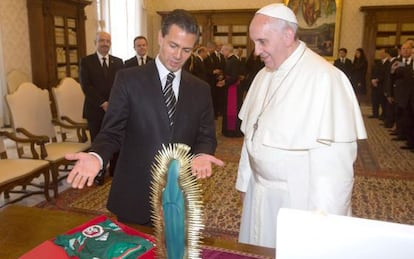Mexico’s Catholic Church attacks government reforms
Pope Francis has promised to return President Peña Nieto’s visit to the Vatican


Mexico’s Catholic Church has launched new offensives against the administration of President Enrique Peña Nieto. The target is his flagship project – a series of reforms his party and the country’s main opposition groups support. The criticism from the Church comes as a surprise given that its leaders – despite their turbulent history in the country – had maintained a cordial relationship with the last few administrations. The first sign of trouble came in late April when the Episcopal Conference unexpectedly issued a sharp official message that shattered any idealization of life in Mexico and, one by one, questioned the proposed reforms, which call for changes in education, taxation, politics and the energy and telecommunications industries. “We ask ourselves: ‘how will they be beneficial,’ especially for those who have always been unfortunate? Or, are they going to be a new opportunity for those who are used to pillaging the resources of this country?” read the message.
A handful of other well-chosen statements from powerful sectors of the Church followed that attack. The most recent dart launched at the government came from the official weekly magazine of the Archdiocese of Mexico. In a vitriolic editorial published this week, the Church accuses the “particracy” of shielding the “power-hungry class” and of having corrupted the electoral reforms by avoiding transparency and preventing citizen participation.
Will these reforms be a new opportunity for those used to pillaging this country?” asked Church leaders
As it often has in the past, the Church made its objections public at a delicate moment for the government. Shortly after the statement at the Episcopal Conference, the bishops took their ad limina visit to Rome to report on the state of affairs in the country, warning about narcoterrorism in various regions.
The trip occurred on the eve of Peña Nieto’s own trip to the Vatican on June 7. During their meeting, Pope Francis and the president exchanged many positive words, with the former promising to travel to Mexico in the near future. Although no date has yet been set for the visit, the pope expressed interest in visiting one of the country’s worst hot spots: the border with the United States.
For now, Peña Nieto has avoided confrontation. After the first few jabs from Church leaders, the president met with bishops to defend his plans for the country’s largest reform agenda in decades. “Poverty is contained when there is growth that allows people to join the active workforce,” he said. The National Action Party (PAN), which represents a large Catholic base, did not endorse the prelates’ statements.
Drug-related terror and the death of 15 priests in the last few years have been key factors in the Church’s decision to change its rhetoric. Even though crime rates are decreasing, these assaults have caused such unease that they have forced Mexican prelates to call for a radical change in mentality. “No reform will help us overcome the intolerable disparities and social injustices that makes us pay more attention to the private lives of performers than the suffering of migrants hurled from trains because they do not have the money to pay the extortionists, or read about kidnappings, the mistreatment of individuals, unpunished criminal activity, kickback payments, violence and decapitated bodies in secret mass graves as if they were mere statistics or news items,” the bishops wrote.
The pope has expressed interest in visiting one of Mexico’s worst hot spots: the border with the US
With this new stance, the Mexican Church aligns itself with the pope’s message and his loud calls to fight against poverty and injustice. “The Mexican leadership was organized according to the imperial style of the papal courts of John Paul II and Benedict XVI,” Bernardo Barranco, a church scholar, said. “They were distant and not very popular. The rise of Pope Francis and his embrace of normalcy disoriented them. This new narrative paralyzed them for months until they made their position clear in the document published at the Episcopal Conference. They will not be revolutionary but they are skeptical of the goodness of those reforms.”
The adoption of the new papal message marks the end of a close relationship between the Mexican Church and the government that began with President Carlos Salinas de Gortari. In 1991, his administration approved an amendment to the 1917 Constitution that started the process to give the Church the recognition it had been denied until then. The next year, the government re-established diplomatic relations with the Holy See. In 1970, 95 percent of Mexicans identified themselves as Catholic but that figure has now dropped to 83 percent. Nevertheless, the Church remains an influential force in the country, and its statement does not forecast any complacency on the part of a nation trying to improve its image, now more than ever. Or, as the bishops wrote: “We can’t allow ourselves to get used to having more than 50 million Mexicans living in poverty, many of them in miserable conditions that condemn them to a death without the aid of medical attention.”
Translation: Dyane Jean François







































